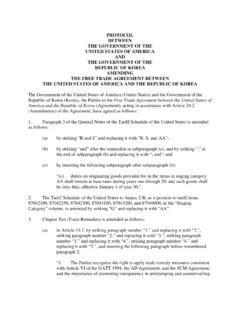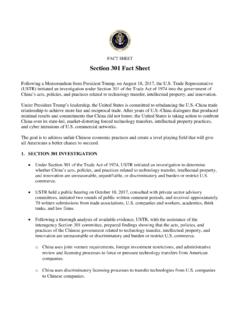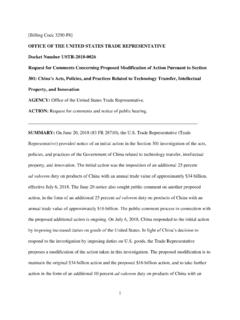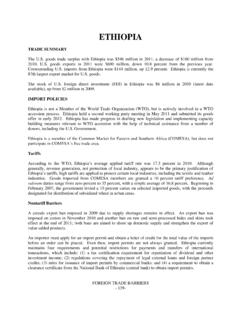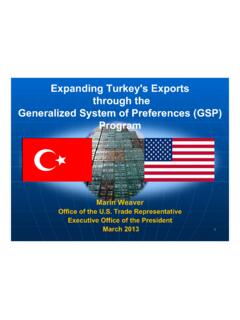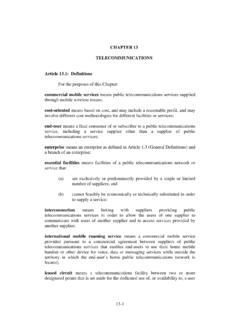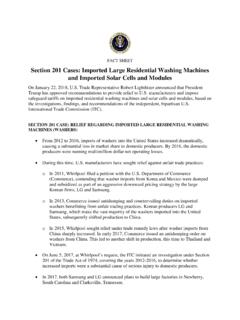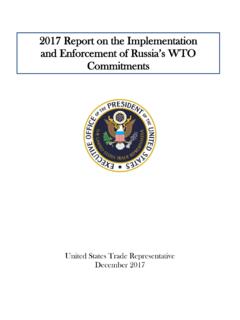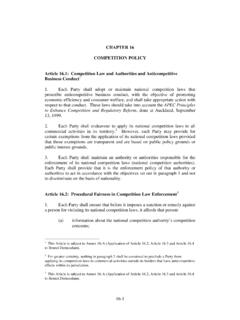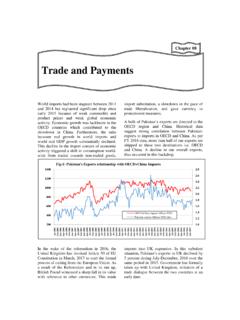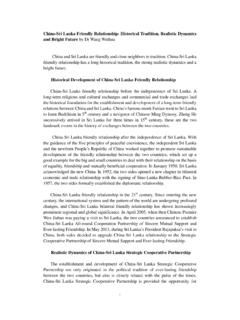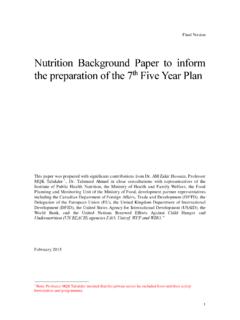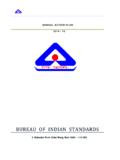Transcription of GUIDEBOOK - United States Trade Representative
1 1 Generalized System of Preferences GUIDEBOOK Office of the United States Trade Representative Executive Office of the President Washington, March 2017 2 TABLE OF CONTENTS Introduction .. 3 Abbreviations and Acronyms .. 4 GSP Program Inquiries .. 5 Frequently Asked Questions about GSP .. 6 Countries Eligible for GSP .. 16 GSP-Eligible Beneficiaries .. 16 Criteria for Country Eligibility under GSP .. 19 Information on Products Eligible for GSP .. 21 Articles Not Produced in the United States on January 1, 1995 .. 21 Articles and Countries Granted Waivers of the Competitive Need 22 Information on Submitting a GSP Petition .. 26 Other Information Sources .. 29 3 INTRODUCTION The Generalized System of Preferences (GSP), a program designed to promote economic growth in the developing world, provides preferential duty-free treatment for over 3,500 products from a wide range of designated beneficiary countries (BDCs), including many least-developed beneficiary developing countries (LDBDCs).
2 * An additional 1,500 products are GSP-eligible only when imported from LDBDCs. The GSP program was instituted on January 1, 1976, and authorized under the Trade Act of 1974 (19 USC 2461 et seq.). Current Congressional authorization of the GSP program will expire December 31, 2017. The purpose of this GUIDEBOOK is to facilitate public understanding of the GSP program and the information contained in the basic implementing documents. The statute and implementing documents remain the controlling authorities. The legislation authorizing the GSP program can be found at 19 USC 2461-2467, and GSP regulations may be found at 15 CFR Part 2007. Both are also available on the Office of the Trade Representative (USTR) website: . The GSP regulations of the Department of Homeland Security s Customs and Border Protection (CBP) may be found at 19 CFR Part through In addition, CBP has posted a variety of information of assistance to importers and exporters using the GSP program at.
3 * As of March 2017, there were 120 BDCs, including 44 LDBDCs. See General Note 4 of the Harmonized Tariff Schedule for the most up-to-date number of GSP beneficiaries: 4 ABBREVIATIONS AND ACRONYMS ASEAN Association of Southeast Asian Nations BDC Beneficiary Developing Country CARICOM Caribbean Common Market CBP Department of Homeland Security s Customs and Border Protection CFR Code of Federal Regulations CNL Competitive Need Limitation GNI Gross National Income GNP Gross National Product CROSS Customs Rulings Online Search System GSP Generalized System of Preferences HTSUS Harmonized Tariff Schedule of the United States IMF International Monetary Fund LDBDC Least Developed Beneficiary Developing Country NTR Normal Trade Relations SAARC South Asian Association for Regional Cooperation SADC Southern African Development Community SIC Standard Industrial Classification SITC Standard International Trade Classification SPI Special Program Indicator TPSC Trade Policy Staff Committee USC Code USITC International Trade
4 Commission USTR Office of the Trade Representative WAEMU West African Economic and Monetary Union WTO World Trade Organization 5 GSP PROGRAM INQUIRIES The GSP program is administered by the Office of the Trade Representative . Public inquiries about the program may be directed to the GSP Program Office at USTR, using the following contact information: e-mail: Telephone: +1 (202) 395-2974 Fax: +1 (202) 395-9674 Public Documents concerning GSP Product and Country Practice Reviews are available online at GSP Program Information is available at: 6 FREQUENTLY ASKED QUESTIONS ABOUT GSP 1. GSP-Eligible Articles Which imports into the United States qualify for duty-free treatment under the GSP? To be eligible for duty-free treatment pursuant to GSP, an import must meet the following requirements (described in more detail below): (1) It must be included in the list of GSP-eligible articles; (2) It must be imported directly from a BDC; (3) The BDC must be eligible for GSP treatment for that article; (4) The article must be the growth, product, or manufacture of a BDC and must meet the value- added requirements; (5) The exporter/importer must request duty-free treatment under GSP by placing the appropriate GSP Special Program Indicator (SPI) (A, A+, or A*) before the HTSUS number that identified the imported article on the appropriate shipping documents (CBP Form 7501).
5 Which articles are eligible for duty-free treatment? Articles classified by CBP under approximately 3,500 eight-digit tariff rate lines are generally eligible for duty-free treatment from all GSP beneficiaries. An additional 1,500 articles are eligible for duty-free treatment when imported from LDBDCs. The combined lists include most dutiable manufactured and semi-manufactured products and also certain agricultural, fishery, and primary industrial products that are not otherwise duty-free. LDBDCs are designated as such pursuant to section 502(a)(2) of the Trade Act of 1974, as amended, and, in practice, are typically GSP beneficiaries that are on the United Nations list of least developed countries. How do I determine if a particular item is GSP-eligible? Articles eligible for GSP treatment are identified in the current edition of the Harmonized Tariff Schedule of the United States (HTSUS), which is published by the International Trade Commission (USITC).
6 The complete HTSUS can be downloaded from the USITC web site ). There is also a searchable version of the HTSUS available at the USITC website. The USITC also maintains DataWeb, a searchable database of import statistics and other information, including product eligibility information for GSP and other preference programs, which can be found at: Another source (less official, updated periodically) is on the USTR website at 1. GSP-Eligible Articles 2. How to Claim GSP Benefits for Eligible Articles upon Entry into the United States 3. GSP Beneficiary Developing Countries 4. Competitive Need Limitations and Requests for Waivers 5. Graduation of a Beneficiary Country from GSP 6. Rules-of-Origin Requirements 7. Imported Directly Requirement 8. Handicraft Textiles 9. Other Topics 7 Can any article be designated as eligible for GSP? No. Certain articles are prohibited by law (19 USC 2463) from receiving GSP treatment.
7 These include most textiles and apparel articles, watches, footwear, work gloves, and leather apparel.* In addition, the GSP statute precludes eligibility for import-sensitive steel, glass, and electronic articles. How is an article identified as GSP-eligible in the HTSUS? The letter A in the Special tariff column of the HTSUS identifies GSP-eligible articles at an eight-digit level. The following table presents three HTSUS tariff lines to illustrate variations in the treatment given to different GSP articles. Under each entry for a GSP-eligible article in the HTSUS, the SPI code A, A+, or A* in the Special column identifies the article as GSP-eligible under certain conditions. The SPI code A designates articles that are GSP-eligible from any BDC. The SPI code A+ indicates articles that are GSP-eligible only from LDBDCs. The SPI code A* indicates that one or more specific BDCs, listed in General Note 4(d) to the HTSUS, have lost GSP eligibility for that article.
8 HTSUS Subheading Article description Rate of Duty (%) Column 1 Column 2 General Special Steam turbines for marine propulsion Free (A,..) 20% Fuel-injection pumps for compression-ignition engines Free (A*, ..) 35% Mufflers and exhaust pipes, not for trackers Free (A+,..) 25% Can the President limit products GSP eligibility? Yes. The President may: (1) remove products from GSP eligibility in response to petitions submitted by interested parties in an annual review; (2) preclude certain BDCs from GSP eligibility for certain newly designated products when those products are designated; (3) limit the redesignation of GSP eligibility to certain BDCs when specific articles are redesignated as GSP-eligible; and (4) remove products for an individual BDC country which has exceeded competitive need limitations (CNLs). How is the correct HTSUS classification determined? CBP classifies imports under the HTSUS.
9 A ruling on the appropriate classification of a product may be requested under Part 177 of the CBP Regulations (19 CFR Part 177) by any person who, as an importer or * The Trade Preferences Extension Act of 2015 (Public Law 114-27), allows certain handbags, luggage, and flat goods to be considered for designation for duty-free treatment under GSP. These products were previously prohibited by law (19 USC 2463) from receiving GSP treatment. 8 exporter of merchandise, or otherwise, has a direct and demonstrable interest in the question or questions presented in the ruling request, or by the authorized agent of such person. A "person" in this context includes an individual, corporation, partnership, association, or other entity or group. The rulings are provided without cost, provide certainty to make an informed business decision, and, if submitted to the New York office as an eRuling request, are provided within 30 days of receipt.
10 Questions concerning the appropriate classification of a particular product should be directed to CBP officers at the port of entry or to: Director, National Commodity Specialist Division Customs and Border Protection Attn: CIE/Ruling Request One Penn Plaza-10th Floor New York, NY 10119 Rulings may be obtained by email or postal mail. Requirements for ruling requests may be found at: . The eRuling template is available at: The eRuling template may be used if you do not need to provide a physical sample of the goods for which you need a ruling. CBP rulings are published and available on-line in a searchable database called Customs Rulings Online Search System (CROSS) at Requests for valuation and preference program qualification rulings should be addressed to: The Commissioner of Customs and Border Protection Attention: Office of Regulations and Rulings Washington, DC 20229 CBP also provides a compliance document to inform importers of the basic requirements of the GSP program, including guidance about establishing internal controls to document the regulatory requirements for substantiating GSP claims.
